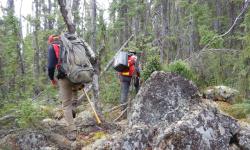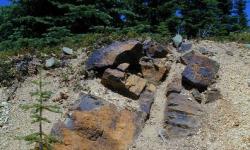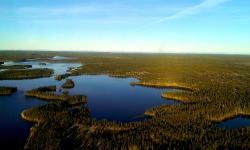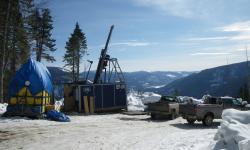Eagle Plains Commences Fieldwork on Eagle Lake Uranium Project
Saskatchewan | September 16, 2009Cranbrook, B.C., September 16th, 2009: Eagle Plains Resources Ltd. (TSX-V:EPL) has mobilized field crews to commence work on EPL’s 100% owned Eagle Lake uranium project located 28 km southeast of Cameco's Key Lake uranium deposit in north-central Saskatchewan, Canada. The focus of the $100,000 exploration program will be to further delineate uranium occurrences discovered during 2007/2008 field programs. Work will be funded by a third party.
The claims cover 14,000 ha and contain numerous uranium occurrences, some discovered by Great Plains Development Company of Canada Ltd. during the 1969 Athabasca Basin uranium rush. The 1969 work program was carried out under the supervision of R.W. (Bob) Termuende, later a founding director of Eagle Plains. New areas of interest have been recently delineated by Eagle Plains field crews, and will be the primary focus of future exploration activity.
Property History
Exploration in the area now covered by the Eagle Lake property by Great Plains between 1969 and 1971 reportedly identified a float boulder train 1.5 kilometers in length. Historical records document that four boulders collected from the float train assayed 0.19, 0.32, 0.56, and 0.50% U3O8 (note these are historical results and cannot be confirmed by EPL). The boulders were collected from an area adjacent to a prominent north-south trending fault structure visible on government aeromagnetic surveys. Great Plains reported high radon gas values from both water and soil samples collected near the uraniferous boulder train. Notably, the bedrock source for these float boulders was not located.
Subsequent work on the property in 1979 and 1980 by Bonn Energy Corporation resulted in the discovery of pitchblende mineralization in veins associated with fault structures. Reportedly this mineralization was visually distinct from the uraniferous pegmatite boulders discovered by Great Plains in the late 1960s, and therefore their source remains undetermined. Following the 1979-80 program, the project geologist concluded in his technical report that “considerable uranium mineralization is present on the property” and that “The probability that this mineralization reflects the presence of a uranium deposit is sufficiently high that work should continue”. A comprehensive program was recommended to further assess the property, but was never carried out.
Mulligan Capital (now Blue Sky Uranium) optioned the property in August, 2006 and in 2007, carried out systematic exploration work including an airborne geophysical survey, soil geochemical sampling, mapping and prospecting. Blue Sky subsequently relinquished its option in August, 2008. A number of areas of interest were identified during the course of this work, including the “Red October” showing, where grab samples returned up to 1.02% U3O8. Follow-up work was completed in September 2008 and included layout of a 7.5 line-kilometer grid with ground magnetic geophysical survey and collection of 195 soil samples completed. Preliminary analysis of results indicate that mineralization is coincident with a pronounced linear magnetic high feature. This magnetic feature is contiguous for at least 1.5 kilometers and is coincident with several radioactive features.
The Eagle Lake property lies within the Wollaston domain and consists of metasedimentary gneisses and schists, including pelitic schists and gneisses with graphitic horizons. EPL will focus on exploring for uranium deposits in north to northwest-trending faults which are interpreted to have formed structural traps where uranium mineralization may have been deposited and preserved.
Update on Iron Range Program
Assay results from a $100,000 trenching and soil geochemical program carried out earlier this season on EPL’s 100% owned Iron Range project (see EPL news release June 2, 2009) have now bee compiled and interpreted. Trenching activity was designed to test for up-dip mineralization encountered in drill hole IR 08006, completed in 2008, which returned 7.0m grading 51.52 g/t (1.50 oz/ton) gold from 20.0m to 27.0m, including 3.0m grading 118.45 g/t (3.46 oz/ton) gold from 20.0m to 23.0m. Results from 2009 sampling returned no significant gold mineralization. Further structural analysis and interpretation is planned to locate possible offsets of the mineralized zone.
About Eagle Plains Resources
Eagle Plains Resources continues to conduct research, acquire and explore metal projects in western Canada. In addition to holding mining royalties on various projects, the Company controls over 35 gold, base-metal and uranium projects, several with third parties including Waterloo Resources Ltd (TSX-V:WAT.P) and XO Gold Resources Ltd. (a private B.C. company). In recent years, Eagle Plains has completed option agreements with Teck Limited (TSX:TCK.B), Alexco Resource Corp. (TSX-V:AXR), Billiton Metals, Rio Algom Exploration, NovaGold Resources, Kennecott Exploration and numerous other junior exploration companies, resulting in over 53,000m (158,500’) of drilling and over $27.0 million in exploration spending on its projects since 1998.
Expenditures during 2008 on Eagle Plains’ projects were approximately $6,000,000, funded equally between Eagle Plains and third party partners. This work resulted in approximately 6,300m of drilling and extensive ground-based exploration work and facilitated the advancement of numerous projects at various stages of development.
On behalf of the Board of Directors
“Tim J. Termuende”
President and CEO
For further information on EPL, please contact Mike Labach at 1 866 HUNT ORE (486 8673)
Email: mgl@eagleplains.com or visit our website at http://www.eagleplains.com
Cautionary Note Regarding Forward-Looking Statements
Neither the TSX Venture Exchange nor its Regulation Services Provider (as that term is defined in the policies of the TSX Venture Exchange) accepts responsibility for the adequacy or accuracy of this release. This news release may contain forward-looking statements including but not limited to comments regarding the timing and content of upcoming work programs, geological interpretations, receipt of property titles, potential mineral recovery processes, etc. Forward-looking statements address future events and conditions and therefore, involve inherent risks and uncertainties. Actual results may differ materially from those currently anticipated in such statements.
Related Projects
Latest News Releases

Eagle Plains and Sun Summit Minerals Execute Option Agreement for the Theory Copper-Gold Project, British Columbia

Eagle Plains and Earthwise Minerals Execute Option Agreement for the Iron Range Gold Project, British Columbia

Eagle Plains and Partner Refined Energy Receive Permit for Drilling at Dufferin West Uranium Property, Saskatchewan

Eagle Plains Announces Letter of Intent with Earthwise Minerals for Option of the Iron Range Project, British Columbia

Eagle Plains Partner Xcite Resources Reports Results From Fieldwork at the Uranium City Area Projects, Saskatchewan


